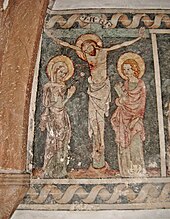Katharinenkapelle (Landau in der Pfalz)
|
Catherine's Chapel from the southeast |
|
| Basic data | |
| Denomination | Old Catholic |
| place | Landau in the Palatinate, Germany |
| Building history | |
| start of building | 1344 |
| Building description | |
| Architectural style | Gothic |
| Furnishing style | square choir, west tower, wall paintings |
| Construction type | Hall construction |
| Function and title | |
|
Originally Beguine Church |
|
| 49 ° 11 '57.1 " N , 8 ° 6' 45.4" E | |
The Katharinenkapelle Landau is a medieval church in the city center of Landau in the Palatinate . It was originally a Beguine Church and now serves as a place of worship for the Old Catholics and the Independent Evangelical Lutheran Church (SELK) .
History and building stock
In March 1315, the German anti-king Frederick the Fair allowed the establishment of a Beginenklause in Landau. The foundation stone of the convent church was laid in 1344, as can be seen from the preserved building inscription. The city council and citizens had them built for the beguines who were very useful as nurses and women in the dead . It was the still existing small hall church in the Gothic style with a recessed, square choir and a west tower. The choir has a ribbed vault with the coat of arms keystones of the Speyer diocese and the city of Landau, the nave has a flat ceiling. The chapel was on the northeast corner of what was then the street market, directly opposite the municipal department store.
After the majority of Landau's citizens had adhered to the Lutheran creed since 1522, the city council determined in 1526 that only one Beguins lived in the city. The convent went under and the church was used as a funerary chapel for funerals from around the middle of the 17th century.
From 1680 Landau was permanently under French rule, which designated the Katharinenkapelle as its garrison church . Apparently the French had the nave subdivided with today's arcade arches, so that a central nave and two side aisles were created inside. To the north and south of the choir, the nave walls were lengthened to the east, the buttresses of the retracted choir were removed and two small additions were made as a storage room and sacristy . This change has now been reversed on the south side.
In the War of the Spanish Succession , Landau was badly affected and the main church there, the simultaneous collegiate church , was damaged. In its place, the Katharinenkapelle served the Catholics and Lutherans from 1702 to 1704 as a common place of worship. Two officers of the imperial army were buried there in 1709 and 1713 , whose magnificent tombs are located on the eastern end of the aisles. One of them is General Hartmann Samuel Hoffmann von Löwenfeld (1653–1709).
The chapel, which is still owned by the city of Landau, was profaned in the course of the 18th century and from then on served as a municipal powder magazine, then as a prison and finally as a hay store. In 1791 a wine merchant bought the building as a warehouse. In 1847 the dilapidated chapel was viewed as an eyesore and intended to be demolished. It didn't come to that. The city administration bought the building back and set up a fruit hall ( market hall ) in it. Large entrances were created on the north and south sides, of which the northern one is still preserved today. The historic tower was also demolished. In the attic of the nave and the choir, a small apartment was built for a city overseer. The choir was added to in the neo-Gothic style, with the upper floor receiving a low, three-part pointed arched window to the east.
In 1872 the Landau city council decided to restore the Katharinenkapelle as a church and handed it over to the newly founded Old Catholic Congregation. In this context, today's roof turret was built to accommodate a new bell. The Independent Evangelical Lutheran Church (SELK) has also been using the Katharinenkapelle as a place of worship since 1960.
Paintings
During a renovation in the years 1958–1960, surrounding wall paintings from the time the church was built were discovered in the choir. It is a passion cycle from the second half of the 14th century, but only partially preserved. Since men marked with Jewish hats also appear in the Passion scenes as the tormentors of Jesus, a fierce argument broke out over the pictures and at times they even intended to cover them up again, which fortunately did not happen. However, copies of the relevant Landau representations were shown in the permanent anti-Semitism exhibition in the Anne Frank House , Amsterdam . A copy is also available in the Berlin house of the Wannsee Conference .
The restorer Arthur Kalbhenn, who reworked many medieval paintings in a very idiosyncratic and sometimes falsifying manner, painted a depiction of the crucifixion with Mary and John above the triumphal arch of the choir based on an illumination model as well as an accompanying ornament to the choir arch. It is not known whether an original finding was present at this point or whether these images are fictitious. The rest of the equipment in the Katharinenkapelle is modern.
gallery
Epitaph Hartmann Samuel Hoffman von Löwenfeld (1653–1709)
Web links
- Web portal of the Friends of Katharinenkapelle
- The Katharinenkapelle Landau, in the Rhein-Neckar-Wiki
- Website for the Katharinenkapelle Landau















